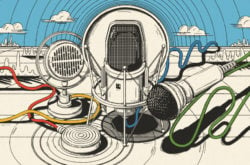The piano is one of the most iconic musical instruments in the world, and there’s a lot that goes into creating that beautiful and dynamic sound we know and love.
It’s pretty easy to get a sound out of a piano compared to most other instruments by just pressing one of those white or black keys. However, that clean exterior hides a sophisticated set of parts that give an experienced pianist all the tools they need to create an unforgettable performance. Let’s run through just how this classic instrument works, as well as the differences between a grand piano and its more compact cousin, the upright.
How a piano produces sound: Keys, hammers, and strings
A 17th-century Italian instrument maker named Bartolomeo Cristofori is credited with inventing the first piano. His experience was in the harpsichord, a Baroque instrument that generated sound by having the player strike a key, which would pluck a corresponding string. However, each note would always come out at the same volume and intensity, giving the player very little control over the dynamics of their performance. The piano was a big leap in this regard because it employs a hammer mechanism that hits strings in response to a key being struck. This allows you to control the loudness of a note by adjusting how hard you hit a key, and even play the same note repeatedly because of how the hammer mechanism quickly returns to its original position.
Everything starts with that iconic row of keys, of which there are 88 on a standard piano keyboard (52 white and 32 black). Modern piano keys are usually made out of wood, with the white keys being covered in a layer of plastic. Once struck, a key will make contact with an internal mechanism called the wippen assembly, which essentially takes the force from hitting the key and applies it to a hammer mechanism. Pressing down on a piano key also causes a damping mechanism to be lifted from the string, which lets it vibrate (once struck by the hammer) for as long as you hold down the key. Letting go of a key will mute the sound of that note as the damper is placed back onto the string.
The internal hammers are also made of wood and covered with a special felt to produce the best sound when hitting a string. Once activated by the whippen assembly, a piano hammer swings forward depending on the force used to strike the key – a forceful hit will swing the hammer quickly towards the string, and produce a much louder sound as a result. As mentioned before, the hammer quickly returns to its original position after bouncing off the string in order to avoid muting the sound, and to allow the same note to be played rapidly if desired.
Finally, the strings – did you know that each note you hear on a piano usually comes from three metal strings all vibrating at once? Multiple strings helps to create that warm, full tone characteristic of the instrument, especially when it comes to higher notes. As you get lower, notes will begin using only two strings, and the very lowest notes are single thick copper wires. The pitch of the string really depends on a few factors including the length of the string, its weight, and how tightly it’s wound. If you count every single string (over 200 in your average piano), there’s almost 20 tons of total pressure being stored in there – and even more in some concert grand pianos!
Pedal power
We’ve gone over how a piano makes sound, but what about those mysterious foot pedals? Piano pedals give the pianist more direct control over the strings themselves. Pressing the pedal to the right (the damper pedal) will remove dampening from all the strings so that notes continue ringing out, even if you remove your finger from the corresponding keys. Pressing the middle pedal (the sostenuto pedal) will also remove dampening, but only for keys that are struck while it’s being pressed. This allows the pianist to play new unsustained notes along with sustained ones. The leftmost pedal is the soft or una corda pedal (meaning ‘one string’ in Italian), and it actually adjusts the internal assembly of the piano so that hammers only hit two strings instead of all three, creating a more subdued overall sound.
The difference between a grand piano and an upright piano
While all acoustic pianos work on the principles described above, there are some key differences between the grand piano you might see in a concert hall and the upright piano more commonly found at home or in a school auditorium. The grand is the most recognizable with its large size and (often equally hefty) price tag. Everything about its construction is done to achieve the absolute best sound quality and playability. The strings are all arranged horizontally, with lower notes being given more space inside of the piano body and a less-rigid housing (compared to the higher strings). You can also open up the top panel to project sound even further. Grand pianos come in several different sizes, and are all generally preferred by professionals because they put the acoustics first.
Here’s what a grand piano sounds like, courtesy of the Studio Grand software instrument available in XLN Audio’s Addictive Keys Complete Collection:
The design of the upright piano makes some concessions in order to produce decent sound while taking up way less space than its fancier counterpart. The construction here is much more boxlike and vertical because the strings are all arranged vertically. This means that there’s much less room (literally) to treat the lower strings differently than the higher ones, which will affect the dynamic range and the tone of the instrument. This arrangement also means that hammers in upright pianos don’t fall back into place as smoothly or quickly, which affects the speed at which you can rapidly hit the same notes. It’s also harder to get a nice sound out of an upright since it mostly comes out of the back of the instrument, which often sits up against a wall. That’s also its greatest advantage – upright pianos are much easier to fit into a home or classroom, and usually a great deal more affordable.
Here’s how an upright piano sounds (played by the Modern Upright from XLN Audio):
Do you have any questions about the anatomy of pianos? What instrument do you want to see us explore next? Let us know in the comments below.
Incorporate high-quality piano sounds into your own music with XLN Audio’s inspiring software instruments:
January 28, 2021



